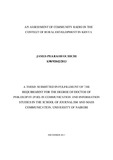| dc.description.abstract | This study was motivated by the fact that there were over 30 community radio (CR) stations in Kenya,
and yet nearly all the areas covered by these stations were beset by a myriad of socio-economic,
environmental, political and other problems, thus raising a pertinent question: Were these stations
operating the way real CR ought to, leading their broadcasting communities into addressing their socioeconomic,
environmental and political problems, but these problems existed because of other factors? Or,
were these stations just commercial, but masquerading as CRs? The study was therefore necessitated by
this inquisitiveness: wanting to know whether CR played its rightful role, or whether something else was
to blame for the state of affairs in many rural communities ravaged by all sorts of developmental
problems. The study hence sought to assess the contribution of CR for rural development in Kenya. The
study employed cross-sectional mixed method design and the theoretical framework was participatory
communication. Data collection was in two stages. The first stage saw data collected from eight CR
stations selected through multi-stage (cluster) sampling. The data gathered, studied and analysed informed
the next stage in which four CR stations: two “successful” and two “unsuccessful” were selected from the
eight for further study. A facilitative model of CR constructed by this study and factors influencing a
successful CR, as espoused by various scholars, were used to rank the CR stations as “successful” and
“unsuccessful”. Whereas in-depth interviews and direct observation methods were used in the first phase,
data gathering techniques employed in the second phase were focus group discussions and survey.
Quantitative and qualitative data were analysed using both quantitative and qualitative techniques and
then presented in tables and narrations, indirect and direct speech. The findings of the study established
that CR in Kenya had made a moderate contribution in rural development. The study concluded that the
stations failed to foster participatory development and programmes were produced by the CR staff,
without incorporating the efforts of the communities. However, to some extent, the stations facilitated the
process of sharing of development information. The recommendations included: enhancement of
community participation in programme production and in the management of the stations; creation of a
strong network of CRs in Kenya; the focus of CR be on a small area, preferably 50 square kilometres;
production of more interactive programmes; and carrying out of research to inform programme-making.
The beneficiaries of the study would be policymakers, CR practitioners and the academia. | |

